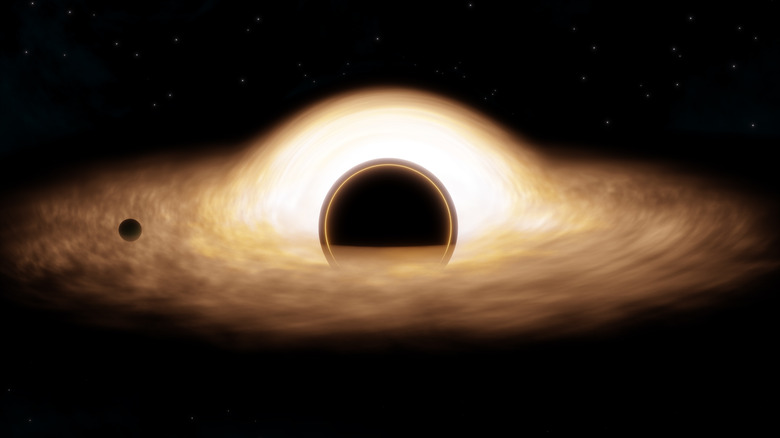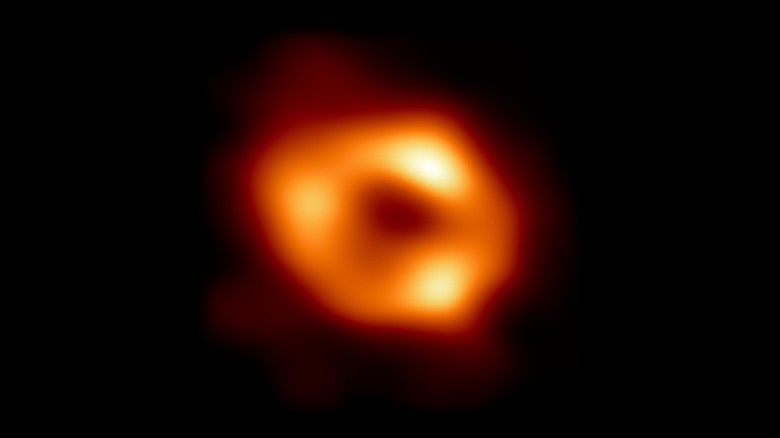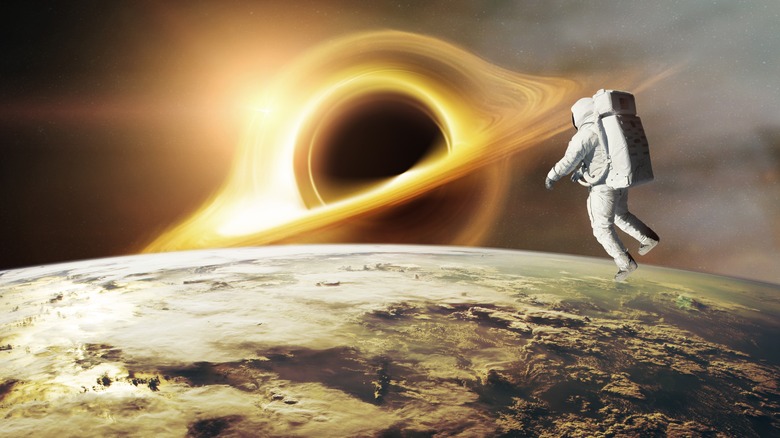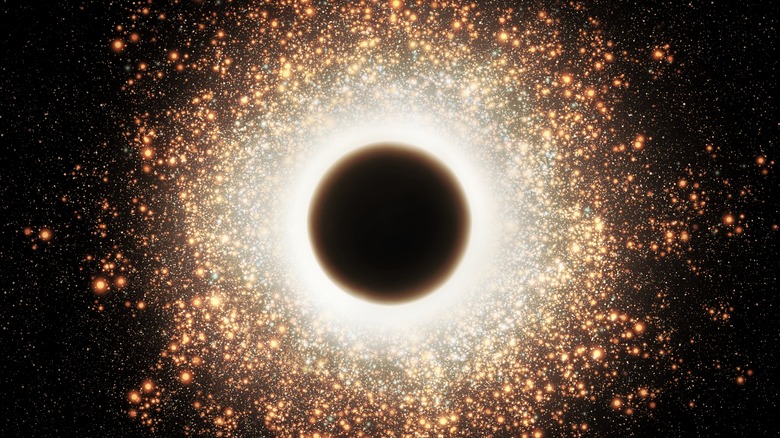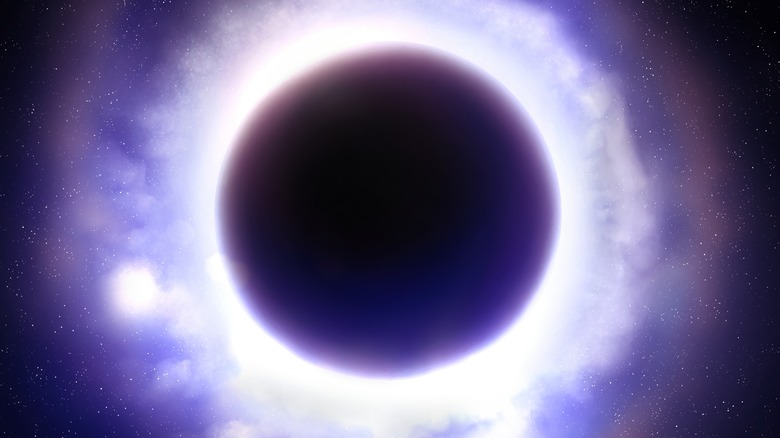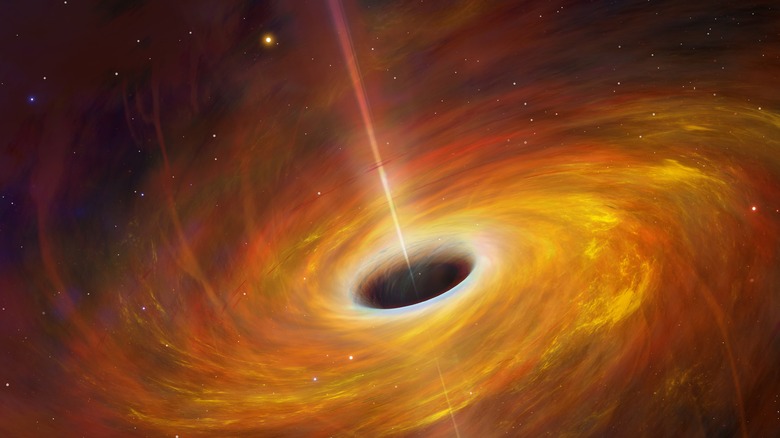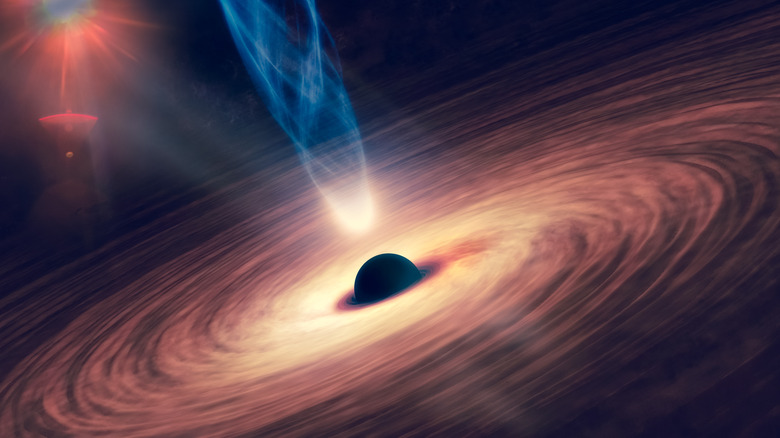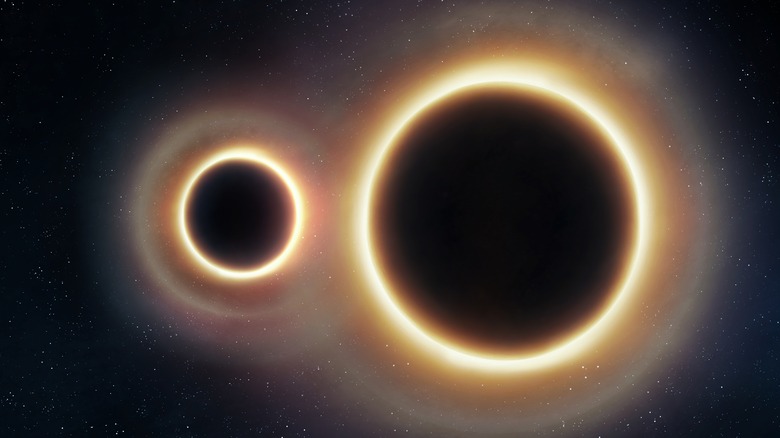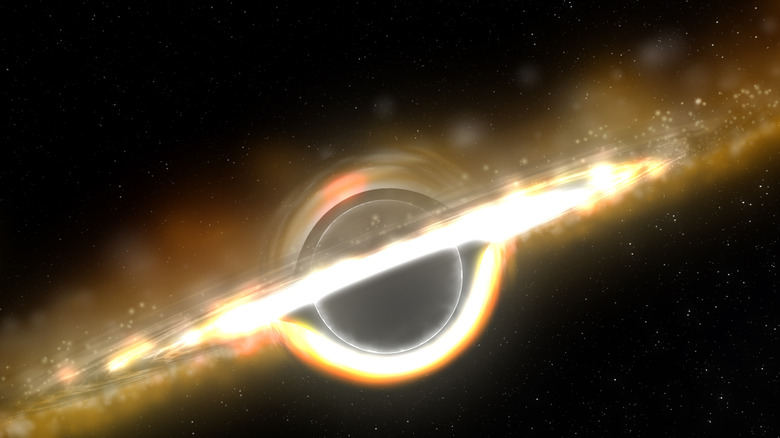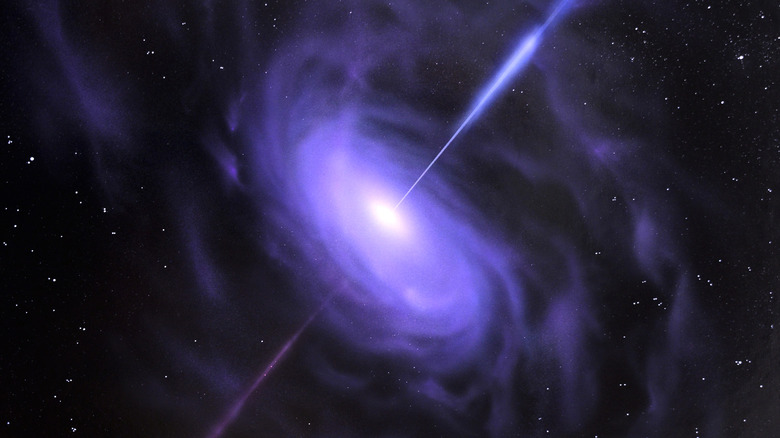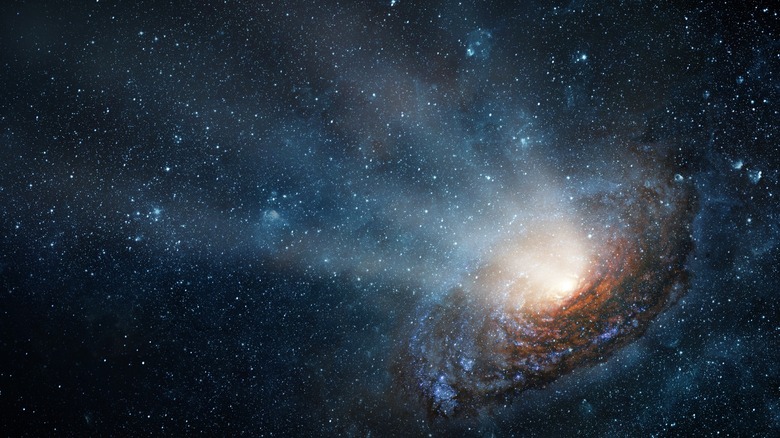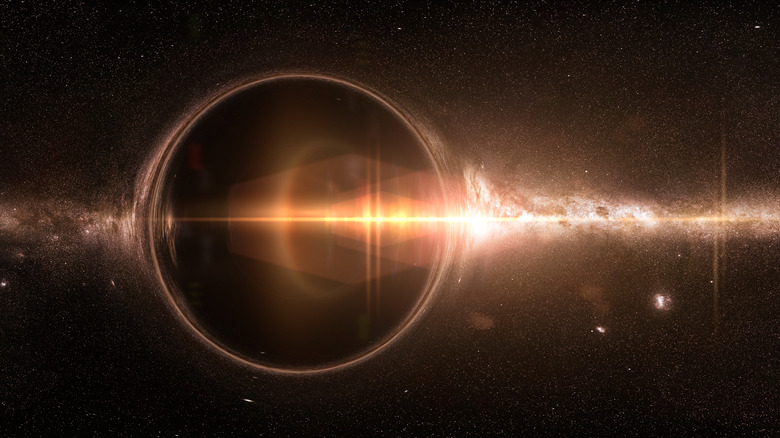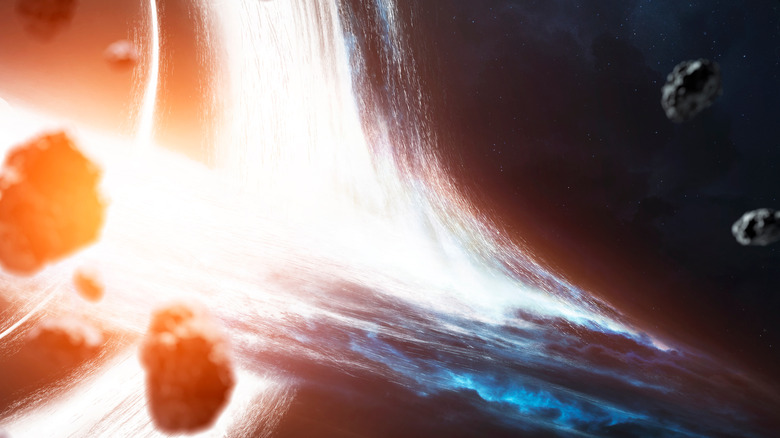The 13 Biggest Mysteries About Black Holes Science Still Can't Explain
One of the most awe-inspiring parts of our universe is the black hole. Up until a few years ago, we weren't even sure they actually existed, but thanks to the dogged drive of astronomers, physicists, and scientists, we learned the phenomenon is not only real but is more widespread than we originally thought.
Despite collecting definitive proof black holes actually exist, we're not much further than we were before in terms of learning how they form or understanding their cause and effect on our Milky Way. However, for all of the nebulous guessing games researchers spend their time solving, some questions stick out the most. Answering any of these 13 questions listed below would not only give us a better understanding of black holes, but of the way our universe works, too. That's why you'll be able to read about latest leading theories for each question and why they're such a hard cases to crack. So get out your telescope, put on your favorite Einstein wig or Nye bowtie, and let's dive in.
What is a black hole?
It seems like a silly question to ask, but we're still not entirely sure what a black hole's composition is or what its main functions are. Some theorize our universe may even be inside a black hole. Right now, the most accepted theory is that they're a clump of matter so dense that its gravity can affect all celestial objects near it. The challenge is that we can only observe them from a great distance, which limits our data collection and testing methods to being nothing but best guesses.
This also adds another layer to the frustration; if we don't understand what they are, then how can we solve any black hole-related problem? Luckily, in April 2024, a research paper published in Physical Review D gave us a new, exciting hypothesis. One of the co-authors, João Luís Rosa, told Live Science that his team's research shows that black holes possibly aren't their own category but instead may be a type of gravastar. Rosa explains, "Gravastars are hypothetical astronomical objects that were introduced [in 2001] as alternatives to black holes ... [and] can be interpreted as stars made of vacuum energy or dark energy: the same type of energy that propels the accelerated expansion of the universe."
Which black hole is closest to Earth?
One might assume that, since we haven't observed any black holes in our solar system's neighborhood, Earth is probably in a safe zone that's far enough away from a black hole that we won't risk being sucked in by it. But we just aren't entirely sure because of, well, the color of black holes; it's hard to observe black objects against the darkness of space. Also, there are no uniform size requirements black holes need to stick to — some have been discovered to be a couple times the mass of our sun, a relatively small celestial object. Meanwhile, an ultramassive black hole discovered in 2023, known as Abell 1201, is approximately 33 billion times the mass of the sun.
So you probably see the problem here — Abell 1201s are easier to find than smaller black holes, but even its discovery took 20 years from our first noticing its arc to getting the full picture. Trying to do that for something 33 billion times smaller in a black sky, with no direction on where to start, makes finding a needle in a haystack seem easy. Right now, the closest black hole we know of is Sagittarius A*, the supermassive black hole in the center of the Milky Way.
Is there a singularity at the center of a black hole?
One of the most migraine-inducing aspects that physicists deal with is "singularity." A singularity is the point at the center of the black hole, where its density is the highest. How high? Scientists believe it's infinite. But physics teaches us that there are no infinities, and if that's the only explanation, then either the math is inaccurate or incomplete. It becomes a paradox that pushes the boundaries of what we think we know and what we can prove.
One potential solution is for João Luís Rosa and his team's theory to be correct about black holes being gravastars, incredibly dense objects filled with dark energy but lacking a singularity. His team looked for spots of gas bubbles orbiting black holes and modeled what should happen to the bubbles if black holes worked as a gravastar. Their findings showed that if they were right, it would solve the paradox because the black hole would be confined to the same rules that Albert Einstein's general relativity says all objects must abide by.
However, their work isn't a smoking gun, as there are still subtle differences in how gravastars and black holes emit light, which could be a significant reason to consider them separate celestial objects. So, for now, a singularity's infinite denseness is still up for debate.
How do supermassive and ultramassive black holes form?
Currently, there are five categories astronomers use for black hole sizing: primordial, stellar-mass, intermediate-mass, supermassive, and ultramassive. Primordials were believed to be the first black holes in the universe and may have been tiny but probably have long since evaporated. Stellar-mass black holes form when the core of a star around 20 times the mass of our sun collapses. Intermediate-mass black holes are currently just a theory, as only one potential candidate has been observed, but scientists rationalize there are probably a few black holes that fall between stellar-mass and supermassive. Supermassive holes, like our friend Saggitarius A*, have a mass ranging from tens of thousands to billions of times our sun. Finally, most researchers believe ultramassive black holes start at around 10 billion times the mass of the sun, but there's no standardized starting point yet.
But here's the problem: If a stellar-mass black hole needs a star around 20 times the mass of the sun, how could something requiring a minimum of tens of thousands of times more mass exist? Right now, the two leading theories think there's an evolution that allows a black hole to grow to these inconceivable sizes. The first, published by Guang Yang and colleagues from Penn State, believes a massive black hole requires a massively sized host galaxy which allows the black hole to expand even more quickly. The other, published by Mar Mezcua and colleagues from the Institut of Space Sciences in Spain, theorizes that black holes grow as they age, with the ultramassive ones possibly getting at least a billion year head start.
What is the relationship between supermassive black holes and galaxy formation?
Which came first, Sagittarius A* or the Milky Way? Did Sagittarius A* make its way over to the Milky Way, or did the Milky Way form around Sagittarius A*? These "chicken or the egg" questions baffle astronomers, and it's easy to understand why. Not only are there no good answers, but the amount of time it would take us to observe one scenario or the other could take at least a millennia for just one formation, let alone the multiple confirmations scientists would want to prove which theory is right.
The closest working explanations we have focus more on explaining the after-effects of the black hole and galaxy anchoring than the cause. First, some context: Astronomers believe there are two types of galaxies – one that's rapidly forming stars, and another that's "quiet" and seems as though it's done growing. A team of scientists from Nanjing University discovered a correlation between the mass of a black hole, the amount of cold gas in its galaxy, and the number of stars being created. The bigger the black hole's mass, the more cold gas that's purged from the galaxy, while the less cold gas, the fewer stars are birthed. So, it's possible that a galaxy forms on its own, and its initial rapid expansion attracts a black hole. As the black hole makes its way into the center (or thereabouts), it begins feeding on the galaxy's resources, depleting the essential ingredients it may need to form more stars.
How do some galaxies end up with black holes that seem too large for their size?
In many ways, nature appears to prefer a balance. So, how is it that some supermassive black holes make their way into a galaxy that's too small to sustain itself and the black hole? If Guang Yang's team's theory is true, then a galaxy and its black hole should grow in tandem. But Jonelle Walsh, an astronomer at the University of Texas in Austin, noticed a galaxy about one-fourth the size of our Milky Way called NGC 1277 with a central black hole approximately 4,000 times the size of Sagittarius A*. Did it start out as too big for its galaxy, or did the black hole continue to grow while NGC 1277 stopped?
Right now, there are no easy answers. Walsh's team is searching the universe for possible inverses where the galaxy is much too large for its small black hole. Not only could a discovery like that help give us a better understanding of how black holes interact with their hosts, but it may shed deeper light into what the metrics need to be and stay at for both objects to grow in tandem.
Are there mini black holes?
One of the worries pop culture popularized upon the release of the Large Hadron Collider (LHC) was that it would create a miniature black hole that would destroy us all once it was turned on. It became one of the more popular black hole myths, really. Luckily, that wasn't the case (uh, spoiler alert?), but it made scientists wonder if baby black holes were even possible. If so, where are they, and what size of star would it take to create one?
Our planet and solar system are in a Goldilocks-type zone where there are no stars close enough to our cosmic neighborhood that are big enough to turn into stellar-mass or supermassive black holes. As for the opposite side of the size spectrum? Well, the jury is still out. The aforementioned primordial black holes, if they existed, were probably tiny since there wasn't a lot of mass yet formed in the early years of the universe.
We do know that if super tiny black holes were possible, like the ones the LHC might cause, they would be too small to have any negative impact. But if they do actually exist, we're not able to definitively tell, thanks to the problem of trying to observe something black in the sky. Our best way to test it is probably not what you want to hear: using the LHC to form them in a controlled environment. Science isn't there yet, so for now, no black holes are capable of forming on Earth.
What happens to information that falls into a black hole?
Stephen Hawking coined the "black hole information paradox" problem — the theory that black holes destroy all information, also known as the Hawking information paradox — which leaves scientists scratching their heads. "Information," in this case, refers to anything that gets sucked into the black hole. If physics says that information cannot be destroyed, then what happens to it inside the black hole where it can never escape? Does it still exist? Physics says it must, but black holes tend to break all the rules physics has, so it's just as possible that it disappears. Thankfully, we may have a glimmer of hope for an answer soon.
Black holes aren't just flat circles; they have peaks and valleys. The peaks, known as "islands," could possibly reach so high beyond the black hole that we could measure them and collect data without succumbing to the hole's gravitational pull. There's also the possibility that "entanglement islands," a type of particle pair, could be living on the surface of the event horizon, giving us another place to collect data on what's going on. But these entanglement islands require a certain type of black hole that is currently only hypothetical. Sorry, scientists, back to the melatonin for you.
How do black holes produce powerful jets that extend beyond their galaxies?
One of the most breathtaking images astronomers talk about is a black hole shooting powerful light beams from both sides of its galaxy's disc. Not only are they surely a sight to see, but they tell us crucial information about the black hole. These light beams are millions of light years long and aren't typically smack dab in the middle, so there's a bit of a wobble to them. This wobble is one thing that lets us definitely determine the spin axis of the black hole, while the length of the beams helps us estimate its size. But if nothing can escape a black hole's gravity, how are these jets forming, and how can they be so powerful?
Luckily, we've found a behemoth pair of jet beams that may give us more clues. In 2024, scientists at Caltech observed the longest light beams yet discovered in the universe with an outflow of energy so powerful it would take trillions of our sun to match them. They've named the beams "Porphyrion" as an homage to a mythological Greek giant and span 23 million light years, or about 140 Milky Ways. Despite being 7.5 million light years away from Earth, scientists are hoping they'll be able to unlock mysteries around how these types of jets form and how they interact with both their host galaxy and black hole.
What is the nature of Hawking radiation, and how does it affect the universe?
When it comes to jet beams, it's also important to talk about Hawking radiation. Named after Dr. Stephen Hawking, who theorized its existence in 1974, this is a type of energy leak that stems from light particles orbiting in a black hole's gravitational field. Previously, Hawking radiation was thought to only come from matter caught in this orbit, but new studies reveal that it's stemming from any type of mass over a certain size. Hawking theorized that this radiation would force a black hole to completely evaporate over time, but now scientists are wondering if its effects are bigger than that.
Originally, researchers believed that this energy leak was caused by the event horizon, but new research is showing that event horizons aren't as impactful as originally thought. Now, leading research is instead theorizing that this loss of energy that all masses over a certain size experience means that it's possible everything in the universe could eventually lose its "resistance," for lack of a better phrase, to collapsing in itself and becoming its own black hole, eventually destroying the entire universe. However, we know so little about the mechanics behind the quantum powers necessary for black holes to function, so these hypotheses are only conjecture.
How do the laws of quantum mechanics apply to black holes?
There's also the frustrating world of quantum mechanics and how it's a constant thorn in the side for astronomers. Quantum mechanics is the law for how particles smaller than atoms operate, as opposed to general relativity (one of Albert Einstein's major breakthroughs), which focuses on much larger objects, like planets and black holes. This sounds simple enough, except for quantum mechanics to be true, it has to allow for rules that general relativity says aren't possible. For example, general relativity says that all objects have a continuous gravity that curves spacetime. This is why you'll often see gravity portrayed as a sort of grid paper that "dips" when a planet is positioned above it. Quantum mechanics says this isn't possible; gravitational fields are not continuous but instead happen intermittently like chunks, and there is no standard set of rules (just probabilities) for how those chunks affect objects.
So, how does this relate to black holes? It's quickest to spare you the math and sum it up like this: General relativity says there must be a singularity to the black hole because gravity is a constant, and the dense gravity of a black hole should crush any information that enters it. But quantum mechanics says that a singularity is not possible and that information cannot be destroyedd. So which one is it? No one yet knows. String theory is a possible solution that can reconcile both laws, but the "chunky" ways quantum mechanics work throw a wrench into it being a perfect answer. There's also loop quantum gravity that theorizes the chunks are a standardized size, albeit very small. So then it's not that small chunks of gravity act intermittently, but instead are a sort of path an object "walks" along.
What happens at the event horizon?
You've most likely heard the theory that if you were able to get to a black hole's event horizon, you'd meet the disturbing fate of anyone who falls into a black hole: You'd get turned into a vaguely human-shaped spaghetti noodle due to the difference in gravity affecting your feet versus your head. While scientists mostly believe spaghettification to be a real phenomenon, they believe that it doesn't happen quite like that and that the event horizon isn't as definitive as it seems. In fact, we're not even sure what role an event horizon actually plays with a black hole.
Some scientists believe that the event horizon is a sort of gate to a firewall, an unimaginably hot wall of energy that would destroy any particle (or person) that touches it. If this were true, it would solve the black hole information paradox. But other scientists believe firewalls aren't possible, so we're back to square one. The problem breaks down to this: We've only just begun to find ways to observe event horizons, so we're only just now scratching the surface on what they are and how they work.
